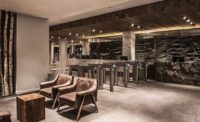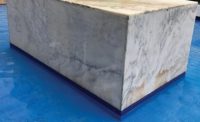“The Steeple building was built in the 1930s, and it is an iconic building on the William Penn Charter School’s campus,” explained Daniela Voith, AIA, LEED, IIDA of Voith & Mactavish Architects LLP in Philadelphia, PA. “It faces onto School House Road, and it [also] opens on to big expansive playing fields, so it is a very important and prominent elevation. When we were given the site directly adjacent to the main building, we were challenged with the concept of designing a building that would complement this iconic building.
“Our design approach was to look at the entire elevation,” Voith went on to say. “We wanted to design it so that it looks like a seamless addition.”
Matching existing stone architecture
The original building was built out of a local stone, which is a very typical Wissahickon Schist, according to the architect. “It has a lot of mica and garnet inclusions,” she said. “It’s a beautiful stone, but a little soft.”
Corrado & Sons Masonry of Barto, PA, supplied the Wissahickon Schist that was utilized for the exterior facade of the new performing arts center. “We tried to get building mortar to look consistent, but the original building was pointed,” explained Voith. “We wanted something that looks old with a sense of timelessness. It was very tricky — a lot of time and attention was put into it.”
Another detail that was carefully considered was the corners of the new building. “There’s pretty gentle quoining at the corners,” said the architect. “We were looking for larger stones to match the detail on the original building. [In the end], the sizes were consistent to the building next door — about 8 inches by 18 inches.”
Additionally, the roof of the Steeple building is made of slate. “The choice [of materials] was pre-determined — schist and slate,” said the architect. “The roof is variegated slate, and also graduated in scale and thickness from the cornice up to the ridge line.”
Finding a match to the slate used on the neighboring building was not an easy task, according to Voith. “It was quite a challenge,” she said. “Slate comes in various colors — black, gray, fading green, unfading green and some purple. Fading green over time turns to pink. Pinkish slate is not out there. You just have to wait [for it to turn]. We did a number of mock-ups to get both the color and distribution.” In the end, the slate was supplied by Vermont Structural Slate of Fair Haven, VT.
Interior stonework
The use of slate carries into the interior spaces of the new David L. Kurtz Center for the Performing Arts. Large-format tiles were all custom cut by Vermont Structural Slate. “Some are straight black, but mostly, they are variegated gray,” said Voith. “The flooring choice came about because the historic building has a combination of slate and marble floors in the entry area. The concept was to tie back to the historic building.”
In addition to the flooring, slate was also employed for a stairway. “The stairs are gorgeous,” said the architect. “They are single pieces of slate on the treads. They are beautifully installed.”
The new performing arts center houses a 650-seat performance space, a band room for 85 and a chorus room for 120. These primary spaces are supported by a full set design/construction shop, dressing rooms/costume storage, music practice rooms, faculty office and library.
A sustainable design
To receive LEED Gold certification, a great deal of planning went into the design of the facility. In addition to local stone, recycled terrazzo glass tile was also used in the construction of the building. A 10,000-square-foot green roof — growing a variety of sedums — covers the theater roof to capture storm water, reduce the heat island effect and provide natural habitat for insects and birds. Additionally, all construction adhesives, sealants, most paints, coating, and all ceiling and wall products have low or no VOCs. Optimal energy performance is achieved as a result of energy modeling and specification of highly efficient HVAC systems, according to Voith & Mactavish Architects LLP.
Moreover, acoustical ceiling tiles, theater railings and the catwalks are all made from recycled materials. Cherry paneling that lines the walls of the theater is made from regional FSC-certified wood.
In total, it took over a year to build the new David L. Kurtz Center for the Performing Arts. “We went through programming, design and redesign to make sure the school gets what they envisioned,” explained Voith, adding that the client was truly satisfied with the end result.
“They love it,” she said. “It was important that the building was designed for use as a school facility, but also a community facility for groups in the neighborhood. The school was lucky enough to be able to do this, and it is a fantastic blessing to the rest of the area to have such a gem.
“Our firm is very proud of the work we did,” Voith went on to say. “A good chunk of the staff devoted a lot of time to this project, and it was truly a team effort in the office. [Also], the builders were incredible. They understood where we were going with the building, and they put their heart and soul into it. You can have all the ideas in the world, but if you don’t have someone to install it properly, what do you have?”











